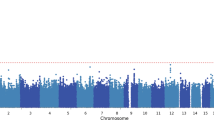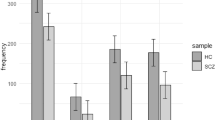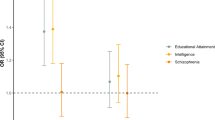Abstract
There has been increasing evidence that deranged superoxide dismutase (SOD) activities might be a risk factor for schizophrenia and/or tardive dyskinesia (TD). In the present study, we investigated the genetic association between a functional polymorphism (Ala−9Val) in the human manganese (Mn) SOD gene and schizophrenia or TD (192 schizophrenics : 39 with TD and 153 without TD; 141 controls). No significant differences in the allelic or genotypic distribution between schizophrenics and controls were observed. However, we did find a significant difference in genotypic distribution between schizophrenics with and those without TD (p = .03). Moreover, decreased −9Ala (mutant) allele was found among patients with TD (p = .02; odds ratio = 0.29; 95% confidence interval = 0.10–0.83). In conjunction with previous findings of increased free radicals and decreased SOD activities in TD subjects, these results suggest that the−9Ala (high activity) MnSOD allele may play a role in protecting against susceptibility to TD in schizophrenics.
Similar content being viewed by others
Log in or create a free account to read this content
Gain free access to this article, as well as selected content from this journal and more on nature.com
or
References
Adler LA, Peselow E, Rotrosen J, Duncan E, Lee M, Rosenthal M, Angrist B . (1993): Vitamin E treatment of tardive dyskinesia. Am J Psychiatry 150: 1405–1407
Armstrong M, Daly AK, Blennerhassett R, Ferrier N, Idle JR . (1997): Antipsychotic drug-induced movement disorders in schizophrenics in relation to CYP2D6 genotype. Br J Psychiatry 170: 23–26
Borgstahl GE, Parge HE, Hickey MJ, Johnson MJ, Boissinot M, Hallewell RA, Lepock JR, Cabelli DE, Tainer JA . (1996): Human mitochondrial manganese superoxide dismutase polymorphic variant Ile58Thr reduces activity by destabilizing the tetrameric interface. Biochemistry 35: 4287–4297
Casey DE . (1991): Neuroleptic drug-induced extrapyramidal syndromes and tardive dyskinesia. Schizophr Res 4: 109–120
Egan MF, Hyde TM, Albers GW, Elkashef A, Alexander RC, Reeve A, Blum A, Saenz RE, Wyatt RJ . (1992): Treatment of tardive dyskinesia with vitamin E. Am J Psychiatry 149: 773–777
Esteban J, Rosen DR, Bowling AC, Sapp P, MuKenna-Yasek D, O'Regan JP, Beal MF, Horvitz HR, Brown RH Jr . (1994): Identification of two novel mutations and a new polymorphism in the gene for Cu/Zn superoxide dismutase in patients with amyotrophic lateral sclerosis. Human Mol Genet 3: 997–998
Grasbon-Frodl EM, Kösel S, Riess O, Müller U, Mehraein P, Graeber MB . (1999): Analysis of mitochondrial targeting sequence and coding region polymorphisms of the manganese superoxide dismutase gene in German Parkinson disease patients. Biochem Biophys Res Commun 255: 749–752
Guidot DM, McCord JM, Wright RM, Repine JE . (1993): Absence of electron transport (Rho0 state) restores growth of a manganese-superoxide dismutase-deficient Saccharomyces cerevisiae in hyperoxia: Evidence for electron transport as a major source of superoxide generation in vivo. J Biol Chem 268: 26699–26703
Gutteridge JM . (1992): Iron and oxygen radicals in brain. Ann Neurol 32(Suppl):S16–S21
Guy W . (ed) (1976): ECDEU Assessment Manual for Psychopharmacology. Publication ADM 534-537. Washington, DC, US Department of Health, Education and Welfare
Horrobin DF, Manku MS, Hillman H, Iain A, Glen M . (1991): Fatty acid levels in the brains of schizophrenics and normal controls. Biol Psychiatry 30: 795–805
Jeste DV, Kelsoe JR . (1997): Schizophrenia, tardive dyskinesia, and D3 receptor gene variant: A new twist on dyskinesias? Mol Psychiatry 2: 86–88
Kane JM, Smith JM . (1982): Tardive dyskinesia. Arch Gen Psychiatry 39: 473–481
Latimer PR . (1995): Tardive dyskinesia: A review. Can J Psychiatry 40 (Suppl 2):S49–S54
Lohr JB, Kuczenski R, Bracha HS, Moir M, Jeste DV . (1990): Increased indices of free radical activity in the cerebrospinal fluid of patients with tardive dyskinesia. Biol Psychiatry 28: 535–539
Lohr JB, Caligiuri MP . (1996): A double-blind placebo-controlled study of vitamin E treatment of tardive dyskinesia. J Clin Psychiatry 57: 167–173
Mahadik SP, Mukherjee S, Correnti EE, Scheffer R . (1995): Elevated levels of lipid peroxidation products in plasma of drug-naive patients at the onset of psychosis. Schizophr Res 15: 66
Malhotra AK, Goldman D . (1999): Benefits and pitfalls encountered in psychiatric genetic association studies. Biol Psychiatry 45: 544–550
Matsumoto T, Uchimura H, Hirano M, Kim JS, Yokoo H, Shimomura M, Nakahara T, Inoue K, Oomagari K . (1983): Differential effects of acute and chronic administration of haloperidol on homovanillic acid levels in discrete dopaminergic areas of rat brain. Eur J Pharmacol 89: 27–33
Miller CH, Simioni I, Oberbauer H, Schwitzer J, Barnas C, Kulhanek F, Boissel KE, Meise U, Hinterhuber H, Fleischhacker WW . (1995): Tardive dyskinesia prevalence rates during a ten-year follow-up. J Nerv Ment Dis 183: 404– 407
Mukherjee S, Mahadik SP, Scheffer R, Correnti EE, Kelkar H . (1996): Impaired antioxidant defense at the onset of psychosis. Schizophr Res 19: 19–26
Müller DJ, Ahle G, Alfter D, Krauss H, Knapp M, Marwinski K, Schulze TG, Weber T, Nöthen M, Maier W, Held T, Rietschel M . (1998): Familial occurrence of tardive dyskinesia. Proceeding of the 6th World Congress on Psychiatric Genetics, Bonn, Germany. Am J Med Genet 81: 527
Ohmori O, Suzuki T, Kojima H, Shinkai T, Terao T, Mita T, Abe K . (1998): Tardive dyskinesia and debrisoquine 4-hydroxylase (CYP2D6) genotype in Japanese schizophrenics. Schizophr Res 32: 107–113
Pall HS, Williams AC, Blake DR, Lunec J . (1987) : Evidence of enhanced lipid peroxidation in the cerebrospinal fluid of patients taking phenothiazines. Lancet ii: 596–599
Reddy R, Sahebarao MP, Mukherjee S, Murthy JN . (1991): Enzymes of the antioxidant defense system in chronic schizophrenic patients. Biol Psychiatry 30: 409–412
Schooler NR, Kane JM . (1982): Research diagnoses for tardive dyskinesia. Arch Gen Psychiatry 39: 486–487
Schwarts PJ, Reaume A, Scott R, Coyle JT . (1998): Effects of over- and under-expression of Cu,Zn-superoxide dismutase on the toxicity of glutamate analogs in transgenic mouse striatum. Brain Res 789: 32–39
Segman R, Neeman T, Heresco-Levy U, Finkel B, Karagichev L, Schlafman M, Dorevitch A, Yakir A, Lerner A, Shelevoy A, Lerer B . (1999): Genotypic association between the dopamine D3 receptor and tardive dyskinesia in chronic schizophrenia. Mol Psychiatry 4: 247–253
Sham PC, Curtis D . (1995): Monte Carlo tests for associations between disease and alleles at highly polymorphic loci. Ann Hum Genet 59: 97–105
Shimoda-Matsubayashi S, Matsumine H, Kobayashi T, Nakagawara-Hattori Y, Shimizu Y, Mizuno Y . (1996): Structural dimorphism in the mitochondrial targeting sequence in the human manganese superoxide dismutase gene. Biochem Biophys Res Commun 226: 561–565
Shimoda-Matsubayashi S, Hattori Y, Matsumine H, Shinohara A, Yoritaka A, Mori H, Kondo T, Chiba M, Mizuno Y . (1997): MnSOD activity and protein in a patient with chromosome 6-linked autosomal recessive parkinsonism in comparison with Parkinson's disease and control. Neurology 49: 1257–1262
Steen VM, Løvlie R, MacEwan T, McCreadie RG . (1997): Dopamine D3-receptor gene variant and susceptibility to tardive dyskinesia in schizophrenic patients. Mol Psychiatry 2: 139–145
Sweet RA, Mulsant BH, Gupta B, Rifai AH, Pasternak RE, McEachran A, Zubenko GS . (1995): Duration of neuroleptic treatment and prevalence of tardive dyskinesia in late life. Arch Gen Psychiatry 52: 478–486
Toru M . (1983): Seishinbunretsubyo no yakuri (Pharmacology in schizophrenia). Chu-gai Igakusha Co, Tokyo, Japan
Tsai G, Goff DC, Chang RW, Flood J, Baer L, Coyle JT . (1998): Markers of glutamatergic neurotransmission and oxidative stress associated with tardive dyskinesia. Am J Psychiatry 155: 1207–1213
Yamada K, Kanba S, Anamizu S, Onishi I, Ashikari G, Yagi G, Asai M . (1997): Low superoxide dismutase activity in schizophrenia patients with tardive dyskinesia. Psychol Med 27: 1223–1225
Acknowledgements
We wish to thank Dr. Akira Etoh, Dr. Yoshitaro Mine, Dr. Yasuhiro Tsutsumi, Dr. Kenji Yamaura, and Dr. Takaharu Hayashida for providing the patient information.
Author information
Authors and Affiliations
Rights and permissions
About this article
Cite this article
Hori, H., Ohmori, O., Shinkai, T. et al. Manganese Superoxide Dismutase Gene Polymorphism and Schizophrenia: Relation to Tardive Dyskinesia. Neuropsychopharmacol 23, 170–177 (2000). https://doi.org/10.1016/S0893-133X(99)00156-6
Received:
Revised:
Accepted:
Issue date:
DOI: https://doi.org/10.1016/S0893-133X(99)00156-6
Keywords
This article is cited by
-
MnSOD and GPx1 polymorphism relationship with coronary heart disease risk and severity
Biological Research (2016)
-
Analysis of manganese superoxide dismutase (MnSOD Ala-9Val) and glutathione peroxidase (GPx1 Pro 198 Leu) gene polymorphisms in psoriasis
Archives of Dermatological Research (2014)
-
Personalized medicine in psychiatry: problems and promises
BMC Medicine (2013)
-
Polymorphisms in Mn-SOD and EC-SOD gene and risk of nephropathy in Western Indian Type 2 diabetic patients
International Journal of Diabetes in Developing Countries (2013)
-
Association of SOD2, GPX1, CAT, and TNF Genetic Polymorphisms with Oxidative Stress, Neurochemistry, Psychopathology, and Extrapyramidal Symptoms in Schizophrenia
Neurochemical Research (2013)



